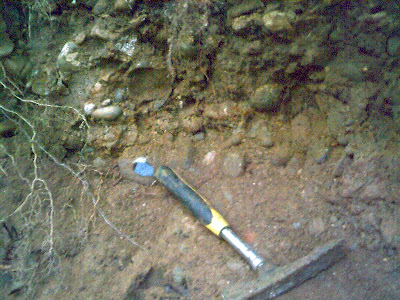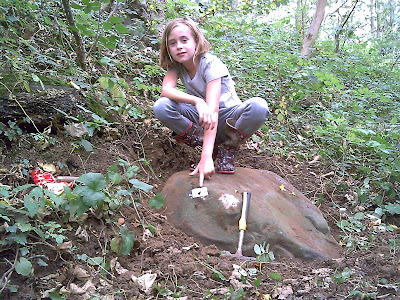I have discovered today that like Stainton, Maltby, and Marton west beck, Ormesby beck has an abundance of whinstone both in the beck and in the same buried packed gravel layer as found at all the other becks.
 The image above shows one of the many pieces of whinstone in the packed gravel layer, and as with Stainton all pieces checked attracted a magnet.
The image above shows one of the many pieces of whinstone in the packed gravel layer, and as with Stainton all pieces checked attracted a magnet.
 Naturally exposed red clay layer Ormesby beck in this area seems more advanced in the processes of cutting through the red clay layer than the other becks.
Naturally exposed red clay layer Ormesby beck in this area seems more advanced in the processes of cutting through the red clay layer than the other becks.
 More Whinstone i would say Whinstone is by far the most abundant rock in this stretch of Ormesby beck, and all tested attracted a magnet.
More Whinstone i would say Whinstone is by far the most abundant rock in this stretch of Ormesby beck, and all tested attracted a magnet.
This is the biggest whinstone boulder ive come across at any location so far, it also attracted a magnet.
 The hammer sits on the red clay layer then the gravel layer then the blue gray layer that contains the organic material then the sandy deposits.
The hammer sits on the red clay layer then the gravel layer then the blue gray layer that contains the organic material then the sandy deposits.
 I am starting to believe all the similar exposed layers in the deepest parts of all five becks are connected ie the same event caused the sequence of deposits in all the becks.
I am starting to believe all the similar exposed layers in the deepest parts of all five becks are connected ie the same event caused the sequence of deposits in all the becks.
 The image above shows one of the many pieces of whinstone in the packed gravel layer, and as with Stainton all pieces checked attracted a magnet.
The image above shows one of the many pieces of whinstone in the packed gravel layer, and as with Stainton all pieces checked attracted a magnet.These images show the gravel layer with the red clay layer below again the same as found at Stainton, Maltby, Marton west beck, and Stainsby beck.

 Naturally exposed red clay layer Ormesby beck in this area seems more advanced in the processes of cutting through the red clay layer than the other becks.
Naturally exposed red clay layer Ormesby beck in this area seems more advanced in the processes of cutting through the red clay layer than the other becks. More Whinstone i would say Whinstone is by far the most abundant rock in this stretch of Ormesby beck, and all tested attracted a magnet.
More Whinstone i would say Whinstone is by far the most abundant rock in this stretch of Ormesby beck, and all tested attracted a magnet.These pics show a natural exposure of the gravel layer with the red clay below, and at least two other deposits above the gravels very much like my main dig at Stainton.

This is the biggest whinstone boulder ive come across at any location so far, it also attracted a magnet.
 The hammer sits on the red clay layer then the gravel layer then the blue gray layer that contains the organic material then the sandy deposits.
The hammer sits on the red clay layer then the gravel layer then the blue gray layer that contains the organic material then the sandy deposits.The gravel layer is very like that at Stainton in having finer orange gravels to the bottom containing organic material

 I am starting to believe all the similar exposed layers in the deepest parts of all five becks are connected ie the same event caused the sequence of deposits in all the becks.
I am starting to believe all the similar exposed layers in the deepest parts of all five becks are connected ie the same event caused the sequence of deposits in all the becks.The only possible way i can think of that deposited this whinstone here and in the other deep beck valley locations is ice, yet i can not explain the uniformed layers theres nothing erratic about these deposits in any of the locations, with the added complication of the organic material in the lower packed fine gravels at Stainton and Ormesby becks uncovered so far ! 


















 This stretch of Marton west beck has by far the largest deposits of Andesite dyke stone i have found anywhere in the south Cleveland area, the gravel layers in the beck banks are full of it, and all tested were magnetic.
This stretch of Marton west beck has by far the largest deposits of Andesite dyke stone i have found anywhere in the south Cleveland area, the gravel layers in the beck banks are full of it, and all tested were magnetic.

































